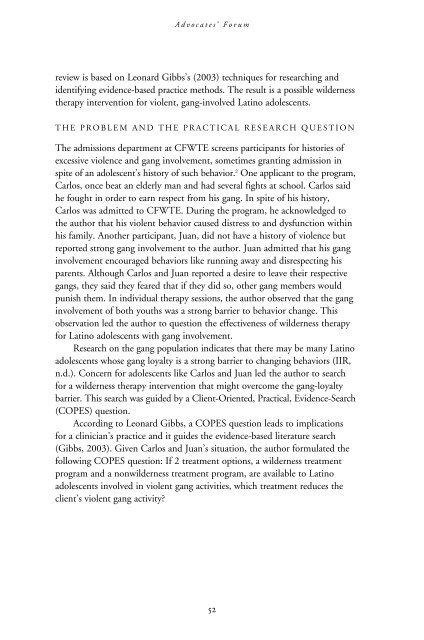2006 - School of Social Service Administration - University of Chicago
2006 - School of Social Service Administration - University of Chicago
2006 - School of Social Service Administration - University of Chicago
Create successful ePaper yourself
Turn your PDF publications into a flip-book with our unique Google optimized e-Paper software.
Advocates’ Forum<br />
review is based on Leonard Gibbs’s (2003) techniques for researching and<br />
identifying evidence-based practice methods. The result is a possible wilderness<br />
therapy intervention for violent, gang-involved Latino adolescents.<br />
THE PROBLEM AND THE PRACTICAL RESEARCH QUESTION<br />
The admissions department at CFWTE screens participants for histories <strong>of</strong><br />
excessive violence and gang involvement, sometimes granting admission in<br />
spite <strong>of</strong> an adolescent’s history <strong>of</strong> such behavior. 2 One applicant to the program,<br />
Carlos, once beat an elderly man and had several fights at school. Carlos said<br />
he fought in order to earn respect from his gang. In spite <strong>of</strong> his history,<br />
Carlos was admitted to CFWTE. During the program, he acknowledged to<br />
the author that his violent behavior caused distress to and dysfunction within<br />
his family. Another participant, Juan, did not have a history <strong>of</strong> violence but<br />
reported strong gang involvement to the author. Juan admitted that his gang<br />
involvement encouraged behaviors like running away and disrespecting his<br />
parents. Although Carlos and Juan reported a desire to leave their respective<br />
gangs, they said they feared that if they did so, other gang members would<br />
punish them. In individual therapy sessions, the author observed that the gang<br />
involvement <strong>of</strong> both youths was a strong barrier to behavior change. This<br />
observation led the author to question the effectiveness <strong>of</strong> wilderness therapy<br />
for Latino adolescents with gang involvement.<br />
Research on the gang population indicates that there may be many Latino<br />
adolescents whose gang loyalty is a strong barrier to changing behaviors (IIR,<br />
n.d.). Concern for adolescents like Carlos and Juan led the author to search<br />
for a wilderness therapy intervention that might overcome the gang-loyalty<br />
barrier. This search was guided by a Client-Oriented, Practical, Evidence-Search<br />
(COPES) question.<br />
According to Leonard Gibbs, a COPES question leads to implications<br />
for a clinician’s practice and it guides the evidence-based literature search<br />
(Gibbs, 2003). Given Carlos and Juan’s situation, the author formulated the<br />
following COPES question: If 2 treatment options, a wilderness treatment<br />
program and a nonwilderness treatment program, are available to Latino<br />
adolescents involved in violent gang activities, which treatment reduces the<br />
client’s violent gang activity?<br />
52
















